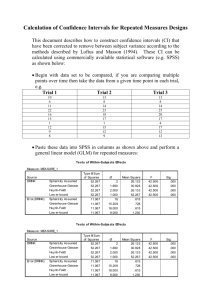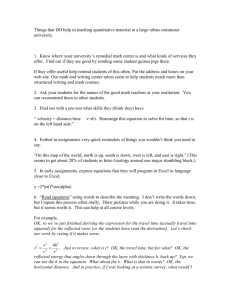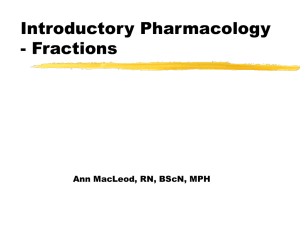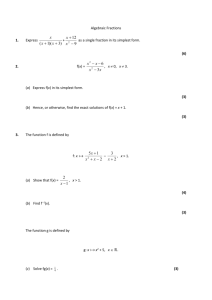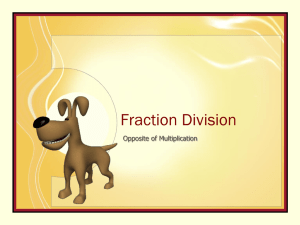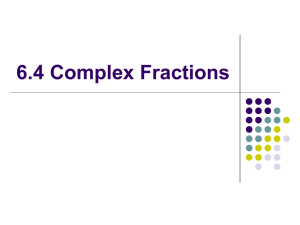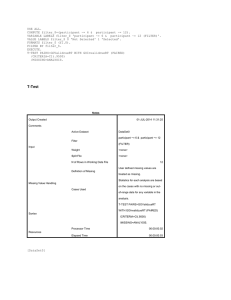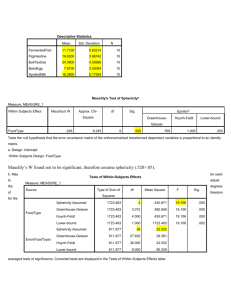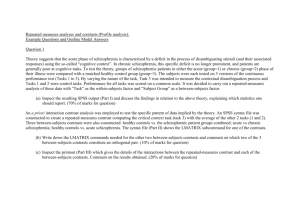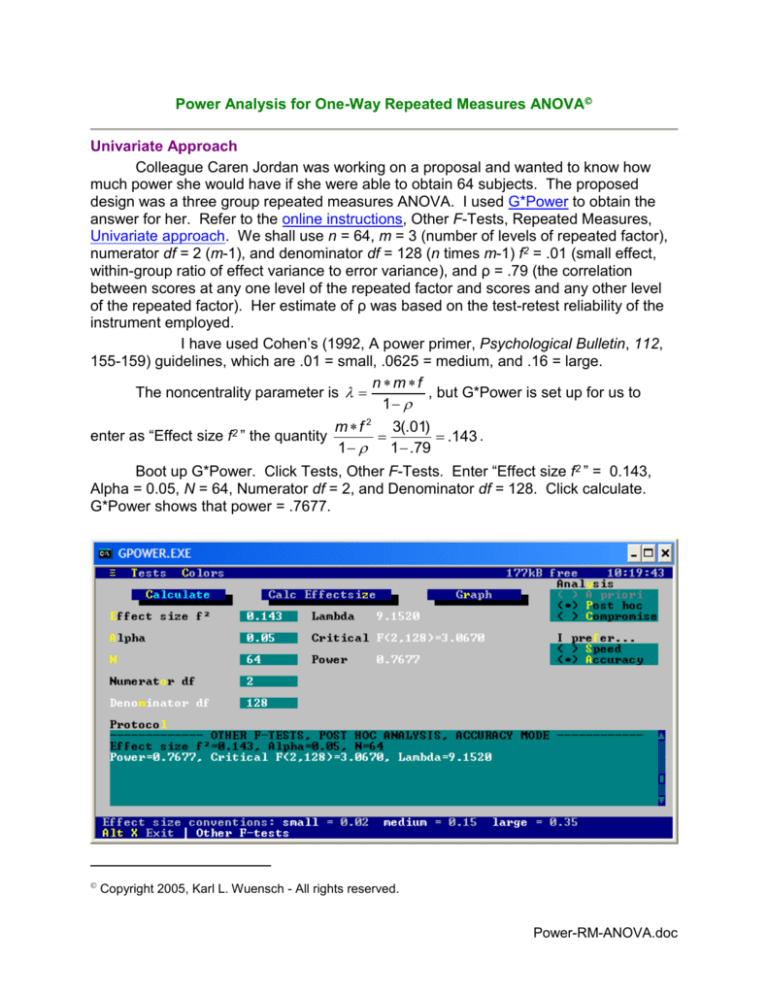
Power Analysis for One-Way Repeated Measures ANOVA
Univariate Approach
Colleague Caren Jordan was working on a proposal and wanted to know how
much power she would have if she were able to obtain 64 subjects. The proposed
design was a three group repeated measures ANOVA. I used G*Power to obtain the
answer for her. Refer to the online instructions, Other F-Tests, Repeated Measures,
Univariate approach. We shall use n = 64, m = 3 (number of levels of repeated factor),
numerator df = 2 (m-1), and denominator df = 128 (n times m-1) f2 = .01 (small effect,
within-group ratio of effect variance to error variance), and ρ = .79 (the correlation
between scores at any one level of the repeated factor and scores and any other level
of the repeated factor). Her estimate of ρ was based on the test-retest reliability of the
instrument employed.
I have used Cohen’s (1992, A power primer, Psychological Bulletin, 112,
155-159) guidelines, which are .01 = small, .0625 = medium, and .16 = large.
n m f
The noncentrality parameter is
, but G*Power is set up for us to
1
enter as “Effect size f2 ” the quantity
m f 2 3(.01)
.143 .
1
1 .79
Boot up G*Power. Click Tests, Other F-Tests. Enter “Effect size f2 ” = 0.143,
Alpha = 0.05, N = 64, Numerator df = 2, and Denominator df = 128. Click calculate.
G*Power shows that power = .7677.
Copyright 2005, Karl L. Wuensch - All rights reserved.
Power-RM-ANOVA.doc
2
Please note that this power analysis is for the “univariate approach” repeated
measures ANOVA, which assumes sphericity. If that assumption is incorrect, then the
degrees of freedom will need to be adjusted, according to Greenhouse-Geisser or
Huynh-Feldt, which will reduce the power.
Problems with the Sphericity Assumption
Correspondent Sheri Bauman, at the University of Arizona, wants to know how
much power she would have for her three condition design with 36 cases. As the data
are already on hand, she can use them to estimate the value of ρ. Her data shows that
the between-conditions correlations are r = .58, .49, and .27. Oh my, those correlations
differ from one another by quite a bit and are not very large. The fact that they differ
greatly indicates that the sphericity assumption has been violated. The fact that they
are not very large tells us that the repeated measures design will not have a power
advantage over the independent samples design (it may even have a power
disadvantage).
The G*Power online documentation shows how to correct for violation of the
sphericity assumption. One must first obtain an estimate of the Greenhouse-Geisser or
Huynh-Feldt epsilon. This is most conveniently obtained by looking at the statistical
output from a repeated-measures ANOVA run on previously collected data that are
thought to be similar to those which will be collected for the project at hand. I am going
to guess that epsilon for Sherri’s data is low, .5 (it would be 1 if the sphericity
assumption were met). I must multiply her “Effect size f2 ,” numerator df, and
denominator df by epsilon before entering them into G*Power. Uncorrected, her “Effect
m f 2 3(.01)
size f2 ” for a small effect =
.055 . Note that I have used, as my
1
1 .45
estimate of ρ, the mean of the three values observed by Sheri. This may, or may not,
be reasonable. Uncorrected her numerator df = 2 and her denominator df = 72.
Corrected with epsilon, her “Effect size f2 ” = .0275, numerator df = 1, and denominator
df = 36. I enter these values into G*Power and obtain power = .1625. Sheri needs
more data, or needs to hope for a larger effect size. If she assumes a medium sized
m f 2
3(.0625)
effect, then epsilon “Effect size f2 ” =
.5
.17 and power jumps to .67.
1
1 .45
The big problem here is the small value of ρ in Sheri’s data – she is going to
need more data to get good power. With typical repeated measures data, ρ is larger,
and we can do well with relatively small sample sizes.
Multivariate Approach
The multivariate approach analysis does not require sphericity, and, when
sphericity is lacking, is usually more powerful than is the univariate analysis with
Greenhouse-Geisser or Huynh-Feldt correction. Refer to the G*Power online
instructions, Other F-Tests, Repeated Measures, Multivariate approach.
3
Since the are three groups, the numerator df = 2. The denominator df = n-p+1,
where n is the number of cases and p is the number of dependent variables in the
MANOVA (one less than the number of levels of the repeated factors). For Sherri,
denominator df = 36-2+1 = 35.
m f 2 3(.01)
.055 . As you
1
1 .45
can see, G*Power tells me power is .2083, a little better than it was with the univariate
test corrected for lack of sphericity.
For a small effect size, we need “Effect size f2 ” =
So, how many cases would Sherri need to raise her power to .80? This G*Power
routine will not solve for N directly, so you need to guess until you get it right. On each
guess you need to change the input values of N and denominator df. After a few
quesses, I found that Sheri needs 178 cases to get 80% power to detect a small effect.
A Simpler Approach
Ultimately, in most cases, one’s primary interest is going to be focused on
comparisons between pairs of means. Why not just find the number of cases necessary
to have the desired power for those comparisons? With repeated measures designs I
generally avoid using a pooled error term for such comparisons. In other words, I use
simple correlated t tests for each such comparison. How many cases would Sherri
need to have an 80% chance of detecting a small effect, d = .2?
First we adjust the value of d to take into account the value of ρ. I shall use her
d
.2
.166 . Notice that
“weakest link,” the correlation of .27. dDiff
2(1 12 )
2(1 .27)
the value of d went down after adjustment. Usually ρ will exceed .5 and the adjusted d
will be greater than the unadjusted d.
4
2
2 .8
285 . I checked this with
The approximate sample size needed is n
d
Diff
G*Power. Click Tests, Other T tests. For “Effect size f ” enter .166. N = 285 and df =
n-1 = 284. Select “two-tailed.” Click Calculate. G*Power confirms that power = 80%.
When N is small, G*Power will show that you need a larger N than indicated by
the approximation. Just feed values of N and df to G*power until you find the N that
gives you the desired power.
Copyright 2005, Karl L. Wuensch - All rights reserved.



